#vietnamese recipes
Text
youtube
Vietnamese Lemongrass Pork Chop & Rice [RECIPE]🍴
#vietnamese recipes#vietnamese pork#vietnamese food#cooking#homecooking#sikfan kitchen#food#foodies#lemongrass pork chop#asian recipes#youtube#food videos#recipes#cooking videos#southeast asian food#Youtube
6 notes
·
View notes
Link
0 notes
Text
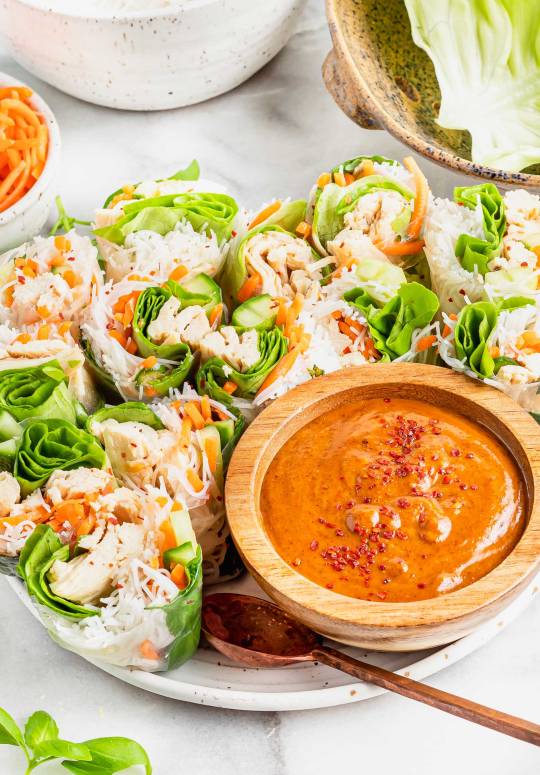
Chicken summer rolls
#chicken#summer rolls#spring rolls#asian food#food#vietnamese food#carrots#healthy food#rice noodles#satay sauce#mint#healthy recipes#meal#tasty#foodporn#delicious#cooking#food photography#foodgasm#recipes
486 notes
·
View notes
Text

Simple Chocolate Cake with Vietnamese Whipped Cream Topping
#simple#chocolate#cake#vietnamese#whipped cream#topping#food#dessert#loaf cake#cake loaf#loaf#recipe#zoebakes
328 notes
·
View notes
Text

Bún Thịt Nướng
#food#recipe#dinner#bun thit nuong#pork#lemongrass#garlic#noodles#vermicelli#daikon#radish#carrots#cucumber#peanut#onions#vietnamese#mint
212 notes
·
View notes
Text

Vietnamese-Style Haddock With Sticky Rice And Crunchy Salad
Ingredients
Haddock
• 4 haddock fillets
• 2 cloves garlic, minced
• 1 tbsp ginger, grated
• 2 tbsp fish sauce
• 1 tbsp soy sauce
• 1 tbsp honey
• 1 tbsp lime juice
• 1 tbsp vegetable oil
• Fresh cilantro and lime wedges for garnish
Sticky Rice
• 2 cups glutinous rice
• 2 1/2 cups water
• Pinch of salt
Crunchy Salad
• 1 cup shredded cabbage
• 1 cup shredded carrots
• 1 cup cucumber, julienned
• 1 cup bean sprouts
• 1/2 cup fresh mint leaves
• 1/2 cup fresh cilantro leaves
• 1/4 cup chopped roasted peanuts
Dressing for Salad
• 2 tbsp fish sauce
• 1 tbsp rice vinegar
• 1 tbsp lime juice
• 1 tbsp sugar
• 1 clove garlic, minced
• 1 red chili, thinly sliced (optional)
Instructions
Sticky Rice
1. Soak the Rice: Rinse the glutinous rice under cold water until the water runs clear. Soak the rice in cold water for at least 4 hours or overnight.
2. Cook the Rice: Drain the rice and place it in a steamer lined with cheesecloth or a thin towel. Steam the rice over medium heat for about 25-30 minutes, until tender. Alternatively, use a rice cooker with the same amount of water and rice.
Haddock
1. Marinate the Fish: In a bowl, combine garlic, ginger, fish sauce, soy sauce, honey, lime juice, and vegetable oil. Add haddock fillets and let marinate for at least 20 minutes.
2. Cook the Fish: Preheat a grill or a skillet over medium-high heat. Cook the haddock fillets for about 3-4 minutes on each side, until cooked through and slightly charred.
Crunchy Salad
1. Prepare the Vegetables: In a large bowl, combine shredded cabbage, carrots, cucumber, bean sprouts, mint leaves, and cilantro leaves.
2. Make the Dressing: In a small bowl, whisk together fish sauce, rice vinegar, lime juice, sugar, garlic, and red chili (if using).
3. Dress the Salad: Pour the dressing over the salad and toss to combine. Sprinkle chopped roasted peanuts on top.
Serving
1. Assemble the Dish: Place a portion of sticky rice on each plate. Top with a grilled haddock fillet.
2. Add Salad: Serve the crunchy salad on the side.
3. Garnish: Garnish with fresh cilantro and lime wedges.
#food#food blogs#delicious#recipe#food pics#homemade#foodshow#food photography#dessert#ideas for dinner#vietnamese
100 notes
·
View notes
Photo
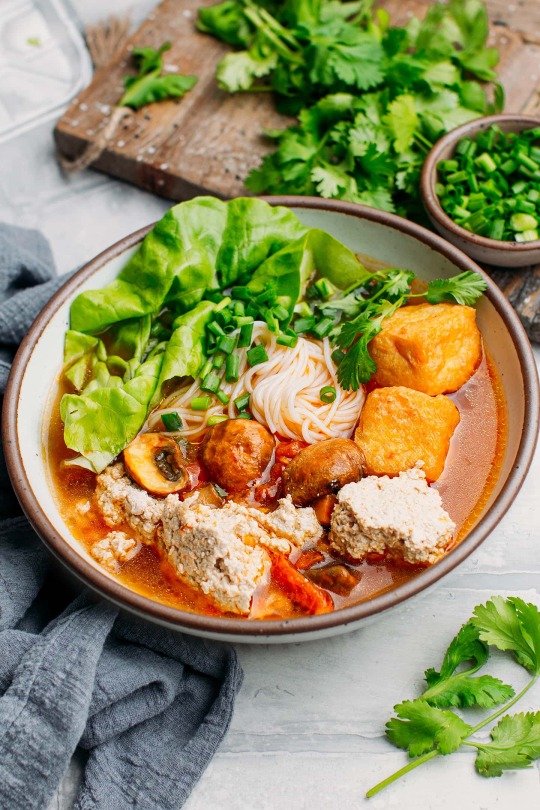
Vegan Bun Rieu
324 notes
·
View notes
Text
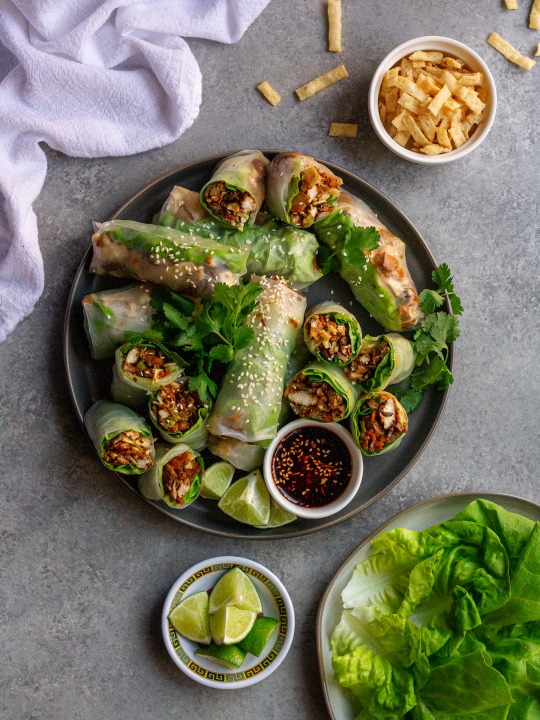
Lettuce Wrap Summer Rolls
#eatfigsnotpigs#vietnamese#vietnamese spring rolls#summer rolls#savoury#lunch#dinner#vegan#veganism#vegetarian#food#recipe#recipes#tofu#mushroom#mushrooms#glutenfree#gluten free#foodporn#food porn#foodphotography#food photography#green#diet#nutrition#weightloss#weight loss#fitspo#fitspiration#fitblr
77 notes
·
View notes
Text
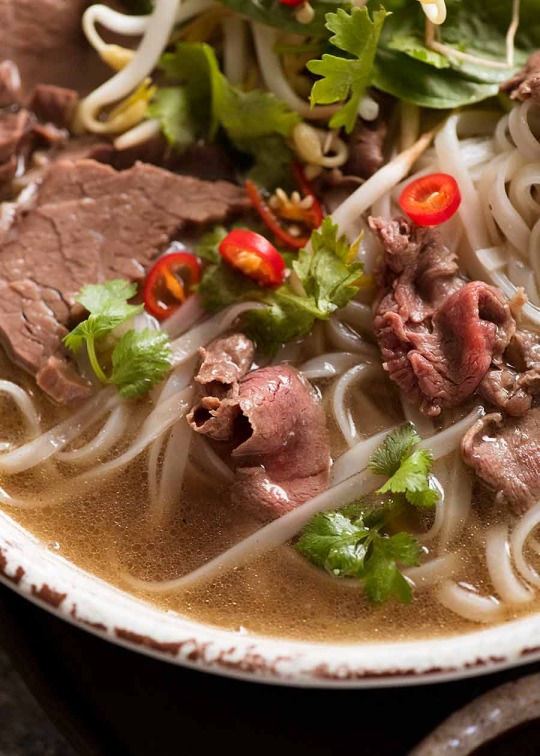

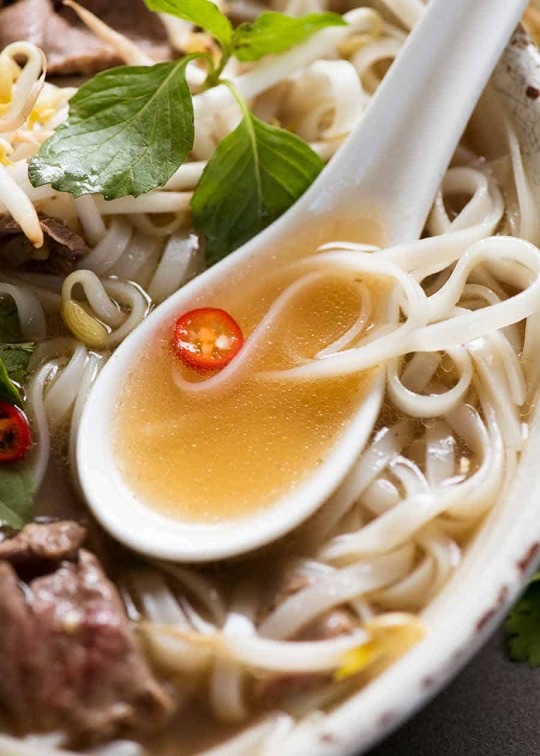
Pho
206 notes
·
View notes
Text

[ID: Five large, enclosed bao piled on a plate. The topmost bao has been opened to show a bread-like dough texture and a vegetable filling. The bao are garnished with chopped chives. End ID]
Bánh bao chay (Vietnamese vegetable dumplings)
Bánh bao are an iteration on the Chinese da bao (大包) brought to Vietnam by Cantonese immigrants. Like da bao, bánh bao are commonly filled with some combination of minced meat, Chinese sausage, and hard-boiled eggs; however, some versions of bánh bao are also made with Vietnamese vegetables, herbs, and flavorings. Vegetarian bánh bao (bánh bao chay) may have no filling, a filling consisting of a variety of vegetables, or a filling of sweetened beans or sweet potato.
This recipe combines Vietnamese vegetables, herbs, spices, and sauces with Vietnamese meat substitutes to make a well-rounded filling that's equal parts umami and fresh. The yeasted, enriched dough is tasty, fluffy, and light, but still has enough structure to hold up against the filling.
Recipe under the cut!
Patreon | Tip jar
Makes 16-20; serves 6.
Ingredients:
For the dough:
4 cups + 2 Tbsp (500g) all-purpose flour
2 tsp (7g) active dry yeast
7 Tbsp (90g) granulated sugar
1/2 tsp salt
2 tsp (10g) baking powder (optional)
2 Tbsp (16g) cornstarch (optional)
1 - 1 1/4 cup (135-295 mL) lukewarm soy or oat milk, or water
1 Tbsp cooking oil
The basic components of this dough are flour, yeast, sugar, salt, oil, and milk. The baking powder is added to help with leavening; the cornstarch works to create a light, fluffy dough that will not become soggy when filling is added.
For the filling:
1 large carrot (100g)
4-inch piece (120g) cassava root / yuca
1 cup (100g) shiitake or wood-ear mushrooms, diced
4 large pieces (50g) sườn non chay, or 1/2 cup diced or crumbled chả lụa chay
1/2 cup water + 1/2 tsp vegetarian 'chicken' broth concentrate (optional)
50g tofu skin (đậu hủ ky)
1 red onion, minced
5 cloves garlic, chopped
4-5 chives or scallions, finely chopped
1 tsp freshly ground black pepper
1/2 tsp sugar, or to taste
1/2 tsp salt, or to taste
2 tsp bột nêm chay, ground to a powder (optional)
1 1/2 tsp fermented bean paste + 1/2 tsp light soy sauce (or 2 tsp vegetarian fish sauce)
2 tsp vegetarian oyster sauce
1/4 cup soybean oil, peanut oil, or other cooking oil, divided
Sườn non chay (roughly, “vegetarian ribs”) is a meat replacement made of textured soy protein. It may be found in bags online or in the pantry / dried goods section at your local Asian grocery store—the bags will be labelled “sườn non chay” as well as “vegan meat slice,” “textured soy bean protein,” “vegetarian food,” or “vegan food.” Most sườn non chay are large and pale in color, but they sometimes come in "beef" or "pork" styles—the difference is not the flavoring but rather the size, shape, and coloring of the pieces. In my experience, the "beef" ones are more darkly colored, and both "beef" and "pork" styles are smaller in size and thinner in shape than the non-specific ones, which I often use to replace chicken.
Chả lụa chay is a vegetarian version of a Vietnamese pork sausage. It can be found in the form of a large loaf in the refrigerator section of a Vietnamese or Asian grocery store. It will be labelled "chả lụa chay" or "gio lụa chay," as well as "vegetarian pork roll," "wheat meat," or "vegetarian food."
Đậu hủ ky, or tofu skin, is prepared by taking the film off of a batch of tofu as it sets. Tofu skin may be purchased fresh or dried, in sheets or in sticks: for the purposes of this recipe, any kind will work! Chinese tofu skin produced for sale abroad may be labelled "dried beancurd sticks."
Bột nêm is a Vietnamese seasoning sold in powder or granule form. Vegetarian ("chay") versions of the seasoning may contain shiitake mushroom, lotus seeds, carrots, tomatoes, and kohlrabi, as well as salt and MSG. It can be purchased in pouches or boxes from an Asian grocery store, or you can use any other vegetable stock powder.
Fish sauce and oyster sauce are common inclusions in pork fillings for bánh bao but are often simply omitted from vegetarian ones. I've used vegetarian substitutes for these ingredients—if you don't have vegetarian imitation fish or oyster sauce, just increase the amount of salt, sugar, and bột nêm to taste.
Instructions:
For the dough:
1. Heat 1 cup (135mL) non-dairy milk to lukewarm in a saucepan or in the microwave. Stir in the yeast to dissolve. if you’re not sure your yeast is alive, proof it by allowing to stand for 10 minutes—it should foam.
2. Add the baking powder, sugar, and salt and whisk to dissolve.
3. In a large bowl, whisk together flour and cornstarch. Pour in the milk mixture and mix well to combine. Add additional milk 1 tsp at a time if it remains too dry to combine. The dough should be slightly tacky but not sticky.
3. Add oil and knead by hand until dough is smooth and elastic, about 10 minutes. Cover with plastic wrap and allow to rise in a warm place for about 3 hours until doubled in size. If you live in a cold climate and don't have a proofing drawer, heat your oven on the lowest setting for a few minutes, turn it off, and then proof the dough in the oven.
For the filling:
1. Prepare the proteins. Soak the tofu skin (if you're using dried) and sườn non chay in cool water for about half an hour until rehydrated (or simmer them for a shorter amount of time). They are fully hydrated once flexible and a couple shades lighter. Gently squeeze the water out. Dice tofu skin; rip sườn non chay into small pieces lengthwise and then dice widthwise.
2. Prepare the vegetables. Peel cassava root and carrot. Cut both into a fine julienne, or grate them. Dice the mushrooms; mince the red onion; chop the garlic.


3. Cook the filling. Heat oil in a large skillet on medium. Add the garlic and sauté until fragrant.
4. Add the red onion and continue to sauté until fragrant and slightly softened. Add black pepper, bột nêm, and salt and allow to cook another 30 seconds.
5. Add carrot, cassava, mushrooms, chả lụa chay (if using), and tofu skin and stir to combine. Reduce heat to low and cook, stirring often, until tender. Remove from pan.
6. If using sườn non chay: in the same pan, fry sườn non chay in 3 Tbsp of cooking oil on medium until they’ve absorbed the oil. Whisk 'chicken' stock concentrate into a small amount of hot water, then add the stock into the pan. Cook until mostly dry.
Soaking in water, deep frying in oil, then simmering in a flavored broth is the typical Vietnamese preparation of sườn non chay. The simmering in stock could potentially be skipped if you're including vegetarian oyster and/or fish sauce, but personally I find that dried soy products benefit from being soaked or simmered in something other than water.
7. Mix sườn non chay in with other filling ingredients, salt, sugar, sauces, and chives.
To assemble:
1. Turn dough out from its proofing bowl and gently divide into two even parts. Cover the half you're not using and gently roll the other out into a log of even width. Use a dough cutter or sharp knife to divide the log into 8 or 10 even pieces.
2. Place each disc of dough on its side and roll it out into a circle about 5" (13cm) in diameter. The edges of the circle should be much thinner than the center, since the edges will be bundled up and folded together.
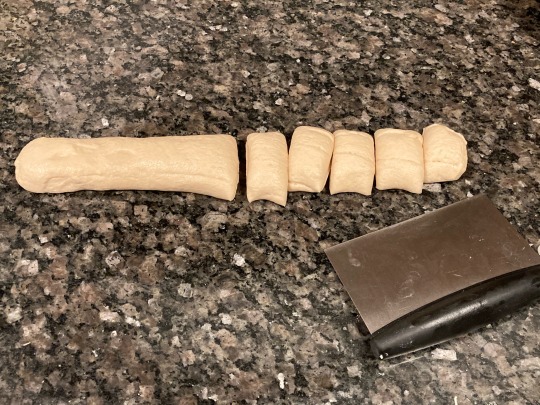
3. The folding method is the same as for baozi and momos. Hold a wrapper in the palm of your non-dominant hand and add a couple tablespoons of filling (if you’re not experienced with making dumplings, it may be easier to add less). While pressing the filling down with your non-dominant thumb, use your other hand to pinch pleated folds in the dough all the way around the circle of the wrapper. Remove your thumb and make one last fold to close the bao. Pinch firmly at the place where all the pleats come together (where the drawstring would be if it were a drawstring pouch) and give a small twist to seal.
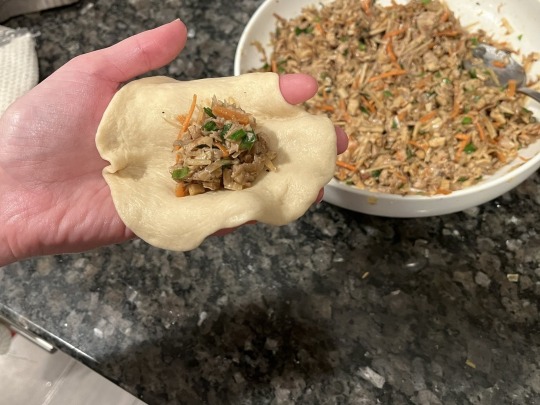
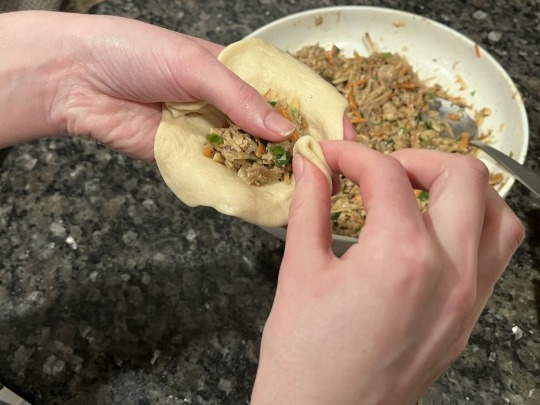
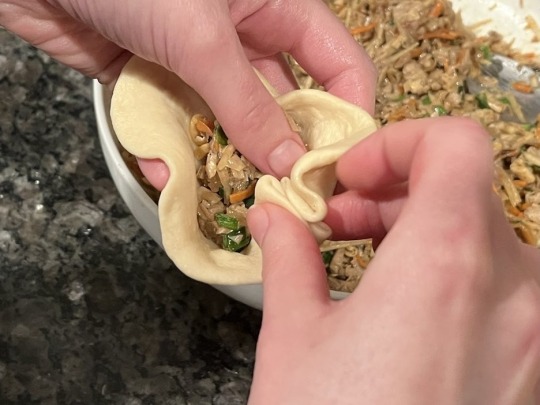


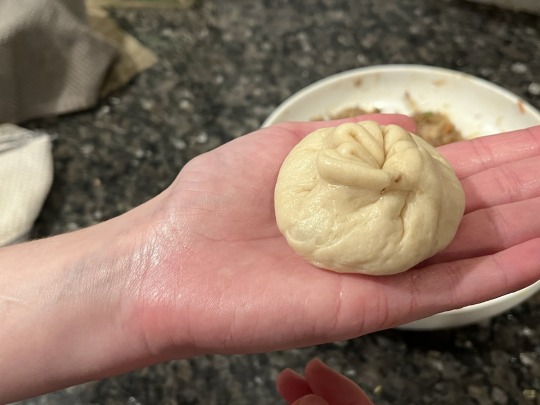
4. Set each finished bao on a small square of parchment paper on a baking sheet or in a steamer and lightly cover with plastic wrap or a light kitchen towel. Continue folding until you have formed all of the bao.
To steam:
1. Place a bamboo steamer in the bottom of a wok or large pot, and fill the wok with enough cool water to cover the bottom rim of the steamer by ½". If you've added baking powder to your dough, you may add a splash of vinegar to the water to help neutralise the dough's pH and combat yellowing of the dough.
If you’re using a metal steamer, tie a kitchen towel around its lid to prevent condensation from dipping back down onto the dumplings. Carefully place the bao, along with their parchment paper squares, into the steamer, leaving an inch or so between each one. They will expand as they steam!
If you don’t have a steamer, place a small bowl in the bottom of a wok or large, deep pan or pot. Place the dumplings, with their parchment paper squares, on a plate and place the plate on top of the bowl–the plate should fit inside your pot. Make sure that you can cover the plate and dumplings with a lid. If your lid is domed, there is no need for a kitchen towel, since the condensation will run down towards the outer rim. If your lid is flat, tie a tea towel around it just as you would with a metal steamer. Fill your cooking vessel with 2 or so centimeters of cool water.
2. Raise the heat to high and allow the water to come to a boil. Once boiling, lower the heat to medium-low and cover your steamer or pot. Steam the dumplings for about 8 minutes, until the dough is tender and cooked through. Keep finished bao warm in a covered casserole dish in an oven on low while you steam the others.
#vegetarian recipes#recipes#vegan recipes#Vietnamese#dumplings#carrots#cassava root#tofu skin#mushrooms#sườn non chay#chả lụa chay#fish sauce#chives
273 notes
·
View notes
Text
youtube
Vietnamese Lemongrass Pork Chop & Rice🍴
#vietnamese pork#vietnamese recipes#vietnamese food#lemongrass pork chop#pork chop#pork recipes#youtube#recipes#sikfan kitchen#food#foodies#food blog#cooking#asian food#Youtube
1 note
·
View note
Text




I've been craving Vietnamese comfort food and decided to cook one. This should satisfy my weekend blues. 😌
Bánh bột lọc served with spring onion oil, chili oil and nuóc mam.
#cheflife#chefs kiss#vietnamese food#comfort food#asian cuisine#asian food#recipes#spicy food#dumplings
18 notes
·
View notes
Text

Banh mi hot dogs
#hot dog#bacon#banh mi#sandwich#food#asian food#vietnamese food#sriracha#carrots#hot dogs#grilling#barbecue#cookout#tasty#foodporn#delicious#cooking#food photography#foodgasm#recipes
340 notes
·
View notes
Text


No Churn Vietnamese Coffee Rocky Road
#vietnamese coffee#rocky road#coffee#ice cream#marshmallow#nuts#food#dessert#recipe#chocolate#peanut#cooking therapy#summer#https://www.cooking-therapy.com/vietnamese-rocky-road/
287 notes
·
View notes
Text

Pandan Waffles
94 notes
·
View notes
Text
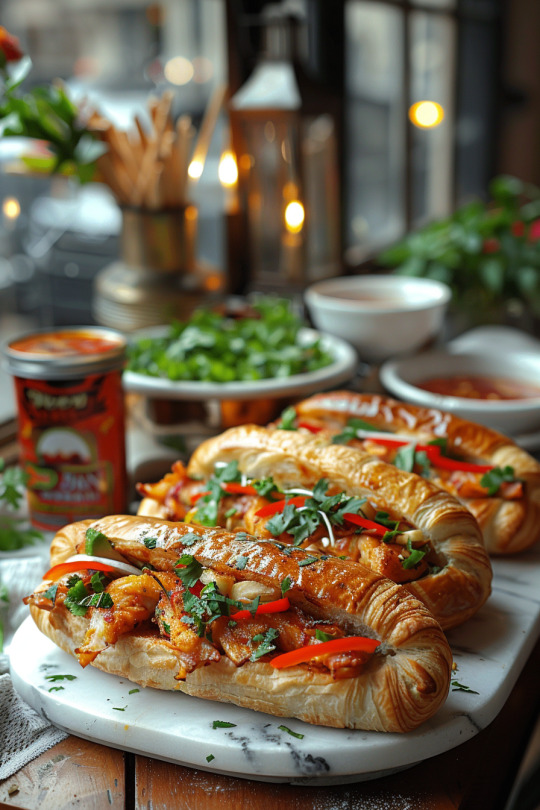
Banh Mi Croissant 🥐 🤤
#banh mi#food#food blogs#delicious#recipe#food pics#homemade#foodshow#sandwich#croissant#good love#food lover#vietnam#parisian#vietnamese#fusion cuisine#home made food
32 notes
·
View notes